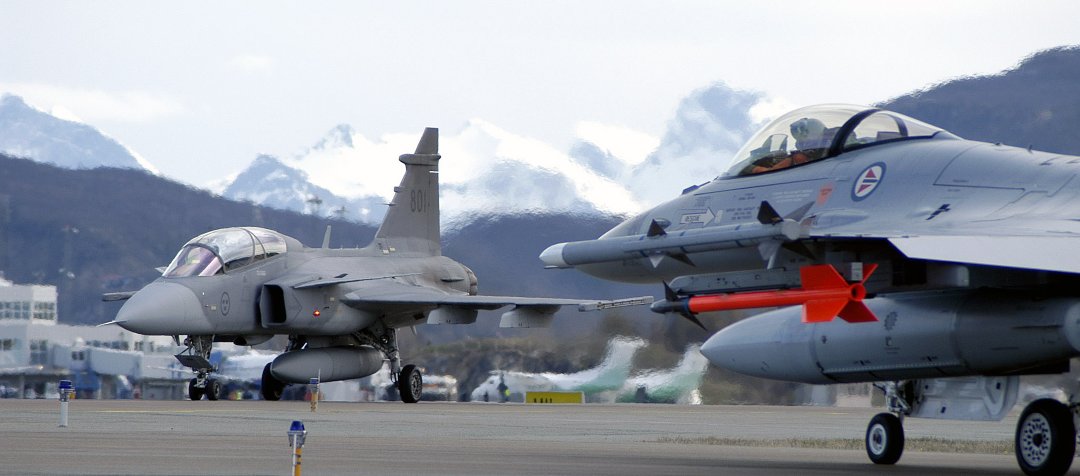
Things have certainly been allowed to cool down after months of momentum on India’s high-profile Make In India fighter programme, peaking during the Aero India show in February. Buzz has plateau’d dramatically following the abrupt departure of defence minister Manohar Parrikar, a vocal proponent of building foreign fighters in country, and the battle that was being fought over the delayed Strategic Partnership policy roll-out. With the crucial framework now around the corner, it still very much remains India’s intention to choose and then build over 100 advanced single engine fighters in a greenfield industrial aerospace manufacturing ecosystem. And for the purposes of such a selection, as we’ve reported here on Livefist before, the Indian government stands presented a choice between two familiar platforms, both eliminated in the infamous M-MRCA contest that resulted in a severely truncated face-saver order for 36 planes as against a requirement of 126.
Between Lockheed Martin, the world’s largest military equipment manufacturer and Sweden’s Saab, a company 1/13th its size, there is little argument about who needs the Indian deal more. There have been capability gunfights in the past between the F-16 and Gripen platforms too, albeit in earlier variants. We don’t need to tell you that winning an Indian contract to build a factory that will churn out maybe 200 jets is going to take much more than edging out your rival in turn rates or cockpit avionics. In every way, the single engine fighter contest is exponentially more ambitious and complex than the M-MRCA.
Unwilling to fire directly at each other, at least officially, what we at Livefist did was invite both Lockheed Martin and Saab to joust it out. On the record. And right here. The ammunition is familiar and time-tested. But placed together in a series of freeze-frames, provides an unprecedented matrix that defines this unusual, looming competition between two aircraft separated by time and space. One, a legendary nothing-left-to-prove jet that’s fighting for a glorious chance to live beyond its time. The other, a brand new jet that bristles with promise, but hasn’t left the nest just yet. A more tantalizing face-off couldn’t possibly be imagined.
Remember, the Indian Air Force itself has compared the F-16 and Gripen before, under the auspices of the M-MRCA, though the two jets had to jostle for attention with four others — the F/A-18 Super Hornet, MiG-35, Typhoon and Rafale. This time, the spotlight rests on two eliminees from the M-MRCA, both light/medium single-engine fighters, a less than tacit admission by the Indian Air Force that the original medium fighter contest was ill-conceived and, let’s say, not predestined for success.
Livefist reached out to both Lockheed-Martin and Saab asking them to list ten pointed reasons why each believed the package involving their aircraft was best suited for the Indian requirement. We then followed this up with more detailed informal discussions with both sides. Let’s begin where it begins.
Okay, let’s kick this dogfight off with both sides jockeying into position:
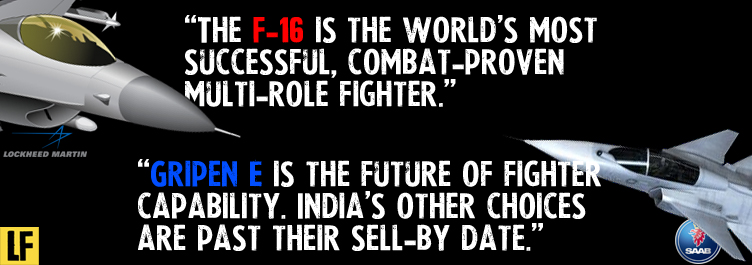
That right there pretty much sums up the core of what Lockheed-Martin and Saab have going against each other. Everything the two companies have on the other is necessarily a version or mutation of this simple, immutable paradox: the F-16 is a successful, explosively proven platform with years of war-chiseled experience on its conformal fuel-tanked shoulders. The Gripen E’s word plays off of that — you had your time, Viper. We’re the future. In its answers to Livefist, Saab added, “Saab’s design philosophy focuses on continuous development, which means that future capabilities can be added to India’s aircraft by Indian engineers in a smooth and effective process for many decades to come. The combat system and capabilities that India needs today are already built into Gripen, we are planning for the systems and capabilities that India will need 10, 20, 30 years from now. India needs, and must have, a future-proof aircraft.”
Lockeed-Martin will be taking that on in a moment. But before that, let’s get into things proper, because remember, India’s single engine fighter contest isn’t a fraction just about the jets.
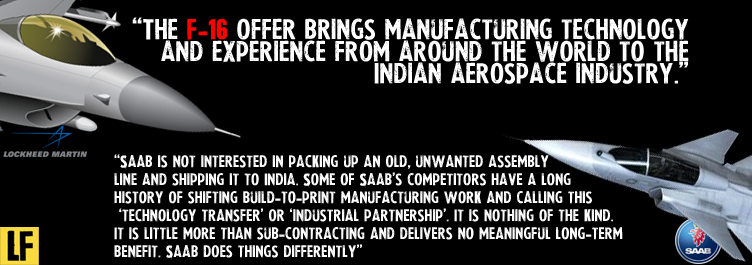
First shots fired. Lockheed-Martin’s stress on its experience from around the world is something they will reasonably push in a big way going forward. And why not? In this interview to Livefist last November, the company’s country lead in India would touch on the global ecosystem and supply chain angle no less than five times. And it isn’t something that can be lightly set aside. But Lockheed-Martin doesn’t take Saab’s swipe that the F-16 is a sunset fighter lightly:
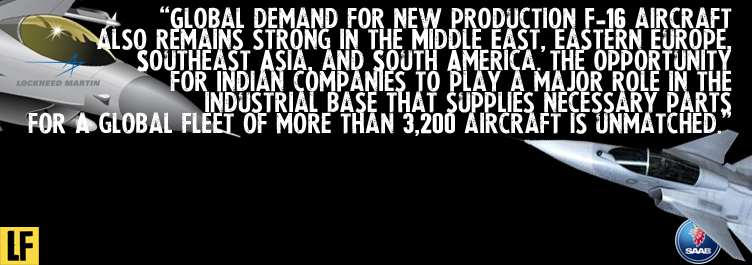
Saab exudes confidence, but doesn’t for a moment forget that its foe is the world’s biggest maker of modern fighter aircraft. A legacy fighter jet with a robust, demonstrable future path is serious business for Saab. From conversations that Livefist had with company executives, it becomes clear that Saab’s countermeasure to this particular thrust — that choosing the F-16 instantly makes India a lucrative sole supplier to a vast, hungry ecosystem — is one of offence: that the F-16’s customers (including, of course, the U.S.) are almost uniformly either looking to replace the type, or plan to very soon. The other counter Livefist gleaned from conversations was that India shouldn’t expect an easy path to F-16 business from foreign operators, especially in the middle east and Europe. Finally, there is the strong submission that future customers of the F-16 are ‘captive’ partners, not countries holding competitive, independent trials. But Lockheed-Martin knows that a substantial global market that has no choice but to plug into the F-16 hub that could emerge in India as it shuts down in the United States, is too tasty a morsel to swat aside so easily.
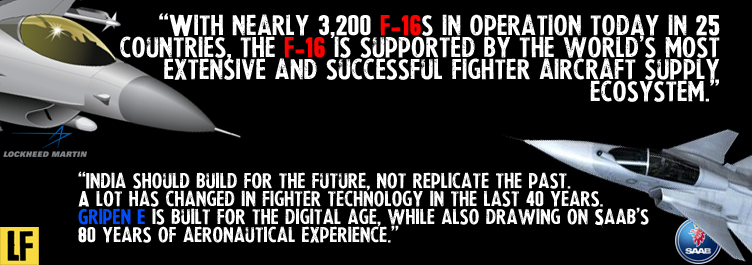
In that particular joust above, it becomes clear that Saab knows it must stress on the future, but also feels compelled to draw on the company’s old heritage; a reminder that isn’t by any means a wet-behind-the-ears latecomer to the industry. At the same time, it mustn’t let go of its core message about being a fighter for the future. And that’s why Saab adds this little flourish in their replies to Livefist: “Think of the smartphones we use today – they have almost nothing in common with the mobile phones of 10 years ago, never mind the landlines. The model-based system design approach [on the Gripen] means that changes in tactical functions can be made very rapidly – because they will not involve requalification of the flight-critical avionics functions. A new weapon can be integrated almost as easily as adding an app, without disrupting the existing system.”
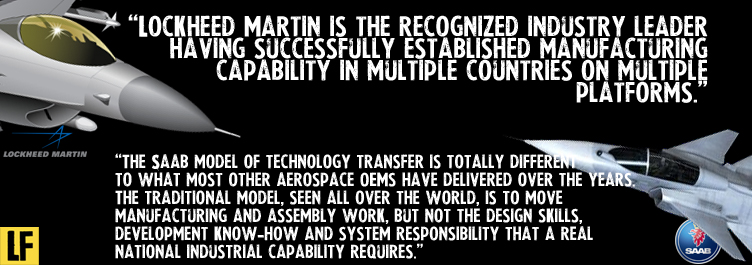
This is an important element in the face-off and is a violent one. Lockheed-Martin suggests it has built platforms abroad before and set up production facilities elsewhere (Turkey and Korea, notably), while Saab never has. The Swedes scoff right back, of course, basically saying ‘If you think that’s manufacture, wait till you see what we’re offering.’ Lockheed-Martin isn’t impressed:
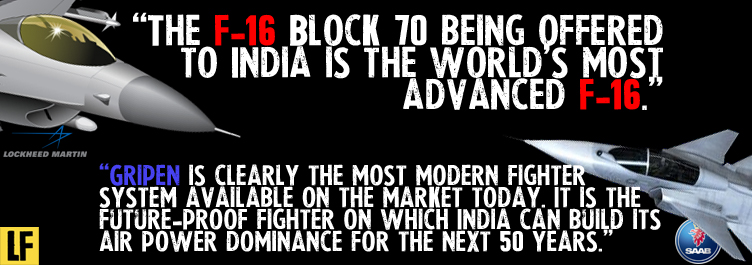
Not a small shot. Drawing upon every fiber that has even makes the F-16 a successful aircraft, albeit a legacy platform, this is Lockheed-Martin jettisoning itself from the idea that the Viper is a doddering old beast ripe with age and well past its retirement date. This is Lockheed-Martin saying, there’s a reason we’ve been around so long and why this is an iconic aircraft, and oh, hey, we’ve just made it even better. And that’s a cue for Saab to invoke a catchphrase you’ll see often in conversations with the company: future-proof.
And now, the fight gets existential. It had to.
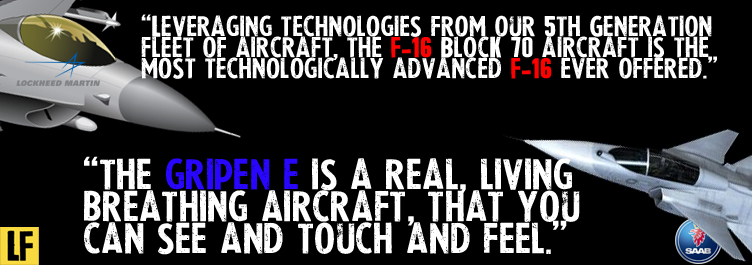
Saab looks to drill it in that the Block 70 Viper isn’t a real plane yet, though it knows such a submission scarcely takes away from the fact that the Block 70 is the next in a vast line of incremental upgrades and improvements on the legacy F-16 — and there’s no particular reason to doubt that the aircraft can exist if India chooses it to. Turning a ‘paper plane’ as some derisively refer to the Block 70, into a flying deal isn’t difficult for the world’s largest fighter maker. Nevertheless, Saab sees the opportunity in underscoring that fundamental (if ephemeral) difference. The company will likely have even more confidence with the Gripen E flying soon.
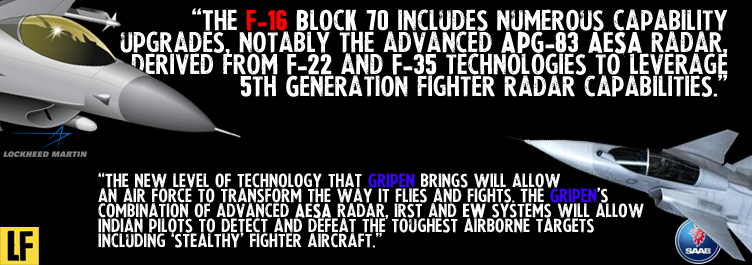
The Northrop Grumman APG-83 Scalable Agile Beam Radar (SABR) AESA in the mix is a superbly interesting addition to the fight. Touted as a fifth generation radar that’s ‘keeping F-16s relevant for decades to come, the company notes, ‘The capabilities of this advanced AESA are derived from Northrop Grumman’s family of highly successful 5th generation fighter AESA radars, the F-22’s APG-77 and F-35’s APG-81’. That’s no joke, coming as it does from the country that pioneered AESA tech. As Livefist has reported before, Saab has a twin-pronged defence to the APG-83 attack: not only does it push the Selex Raven AESA as being a worthy system, but also offers Gallium-Nitride (GaN) based AESA technology for a new generation of aircraft radars. Expectedly, neither side believes the offering from the other is a big deal. What Saab executives do wonder about, though, is if, like Sweden, India will receive source codes for the APG-83 as part of the Make in India package.
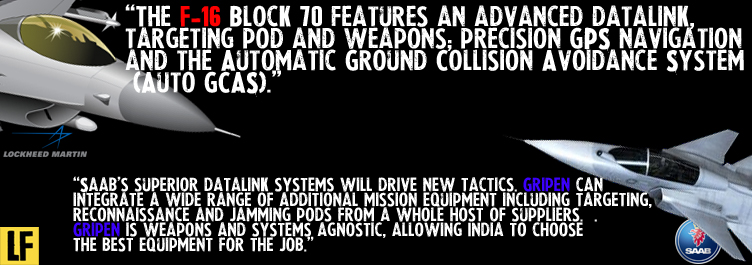
This, ideally, should be a separate post altogether. Performance aside, a systems and equipment comparison between the F-16 Block 70 and Gripen E could fill many hours. Saab knows it goes head-to-head with battle hardened and honed systems on the F-16, but still offers that the ‘combat systems capabilities built into Gripen are second to none’. Faced with a smorgasbord of formidable, proven weaponry that’ll come slung on the F-16, Saab has a robust and specific counter. In its answers to Livefist, Saab chose to highlight three weapon systems it believes tips the scales for the Gripen E: the Meteor BVRAAM missile, RBS 15F ER anti-ship missile and the Taurus stand-off weapon.
Eager to ward off the ‘experience’ factor, Saab also highlights inherent design concepts on the Gripen E thus: ‘[Gripen’s inherent design concept] is its ability to cooperate in large units, sharing targets and friendly ship information and cooperating when launching weapons. Gripen’s sensor fusion feature is crucial for communicating all target detection and tracking information to the pilot. This turns information superiority into high situational awareness. Gripen fighters share all information via tactical data links, including the NATO Link 16. This is key to the aircraft’s information superiority. In addition, each pilot can receive data from controllers on the ground or in the air. A digital CAS and video link enables further communication benefits.’
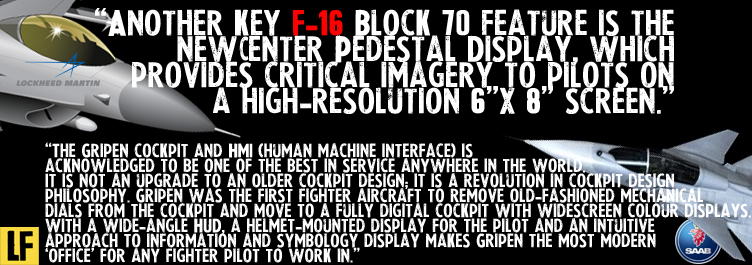
We can’t wait to see how this one turns out, especially since both cockpits are substantially new — and nothing like the cockpits in the F-16 and Gripen fielded in the M-MRCA. And having underscored its very on-board systems, the F-16 cruises into its most vulnerable spot — relevance going forward. With signature lack of time for small talk, Lockheed dives right into it.
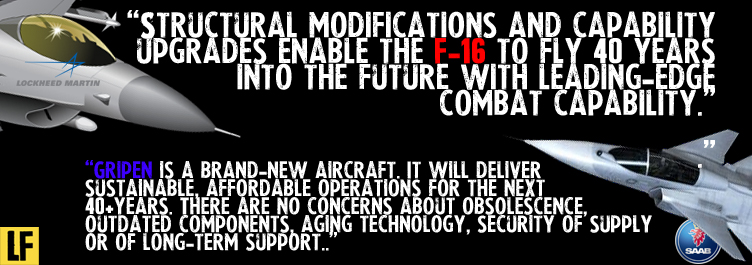
Pulling up from that engagement, Lockheed-Martin decides its time for some offence, hitting straight back at Saab on the jibe a little earlier in the fight, that the Swedish offer wasn’t about cookie-cutting fighters in country, but an actual industrial aerospace deal that benefits India.
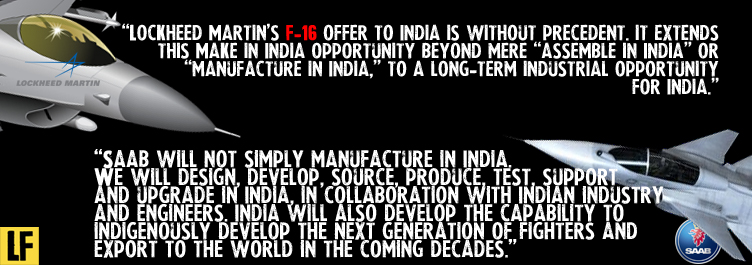
Questions have inevitably arisen in the last few months over whether the Trump Administration would play ball with such an ambitious shifting of the F-16 production ecosystem to India. Saab executives wonder if this lack of predictability could be the undoing of an otherwise worthy foe in Lockheed-Martin. The latter, however, is fully confident. And this is where it begins to get very interesting, throwing up a paradox that Lockheed-Martin must deal with directly. If its a top-of-the-line fighter project with so much life and potential left, why would President Trump sign off on transferring it to India. On the other hand, if Trump does so (and there’s no reason to believe that he won’t), is India to understand that Trump doesn’t consider the F-16 line worth keeping alive in the United States? Thing in reality are, of course, far more complicated than that, but it’s a weird paradox that cannot be ignored. Especially since the current American administration has specifically demonstrated the ability to reduce even difficult issues to black and white. To be sure, this potential paradox came up in discussions Livefist had with officials at the Make In India department and with MoD acquisition planners. Remember, however, that Lockheed-Martin remains one of the most influential companies in the world, one that has demonstrated the ability to sidestep bigger paradoxes (and landmines) in the past.
And finally:
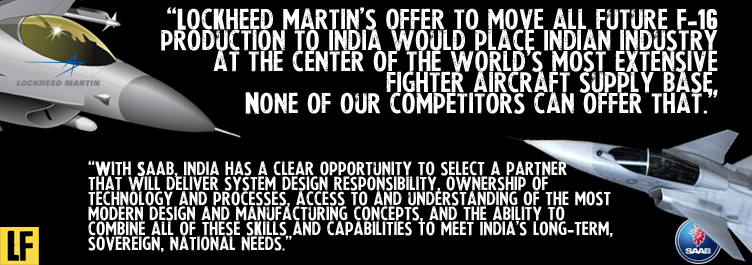
Aha! Sovereign. A word bristling with with meaning and innuendo that Saab wielded so aggressively during the M-MRCA contest as well. The assertion brims with implication: that Sweden would never interfere with India’s decisions on how to use platforms it builds. Unlike the U.S. — that’s the overpowering message. This is an important emotional shot that Saab sees benefit in stressing. While Lockheed-Martin hasn’t specifically countered the ‘sovereignty’ attack, the truth is India has inducted billions of dollars worth of American-built and governed military aircraft in the last decade, with billions more in the pipeline. This would appear to suggest that India has dealt with any ‘sovereignty’ or interference concerns it may have had in the past. Sure, India may have decided to set concerns aside for transport and special mission aircraft like the P-8Is, C-17s, C-130s and CH-47 Chinooks, but has similarly signed up for AH-64 Apache Longbow frontline attack helicopters. And while it’s certainly a leap from those platforms to multirole fighters capable of nuclear strike, it may not be the long one Saab perhaps hopes it is. On the other hand, the promise of non-interference and guarantees of cooperation in all circumstances are valuable to a country like India.
A concern that pops up often when talking of the Indian single-engine fighter bid is whether such a production line would sound the death knell to India’s own Tejas light fighter. This is a credible concern, given that the Tejas — on order for 123 aircraft in a mix of Mk1 and under-test Mk1A variants — is in squadron service, but hasn’t been fully cleared for operations yet. The Indian government sees the single engine Make in India fighter programme as an aerospace enabler not just for the Indian private sector, but also as a source of technology for the Tejas programme going forward, and into the fifth generation AMCA. Both Lockheed-Martin and Saab have specific package offers for the Tejas. On the AMCA, Lockheed-Martin has conspicuously kept away from offering cooperation, in hope and anticipation clearly of the F-35 maybe finding a foot in the Indian door.
The M-MRCA made an embarrassing mess of assessing cost of ownership and lifecycle expenses on purchased fighters, one of the reasons why the contest in its original form collapsed in a heap of smoke. Expect the Indian single-engine fighter deal to have a greater definition of cost going forward, from the tactical to the ownership level. Saab took this direct shot at L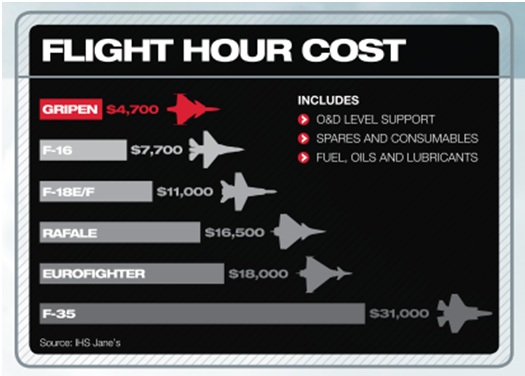 ockheed-Martin for the purposes of this Livefist dogfight with this graphic, sourced from IHS Jane’s data (based on a study commissioned by Saab in 2012) depicting cost per flight hour across modern fighters. The F-16 in question is the Block 40/50. (Also see: This piece from 2013, and this one from 2016 claim to report “official” U.S. government figures for cost per flight hour).
ockheed-Martin for the purposes of this Livefist dogfight with this graphic, sourced from IHS Jane’s data (based on a study commissioned by Saab in 2012) depicting cost per flight hour across modern fighters. The F-16 in question is the Block 40/50. (Also see: This piece from 2013, and this one from 2016 claim to report “official” U.S. government figures for cost per flight hour).
In its answers, Saab said, ‘[The Saab approach] stresses on cost being a part of the early design requirement on par in priority with operational and technical design goals. Other reasons behind breaking the cost trend include a modern diagnostics system which aims at substantially reducing time, personnel and equipment needed for fault localization and ensures high reliability, availability and maintainability. High availability is vital for air forces; they rely on aircraft that offer a long Mean Time Between Failure (MTBF) and short Mean Time To Repair (MTTR). Gripen E has been designed with this in mind. For example, the entire engine can be exchanged and tested in the field in less than an hour. These properties, together with low maintenance requirements per flight hour, give the aircraft higher availability than its competitors. Gripen E has also been designed for minimal turnaround time. For example, an air-to-air combat set up takes only 10 minutes to perform, including refueling and rearming.’
We’ll be keeping this post open, in the event that Lockheed-Martin and Saab wish to add to the dogfight based on the picture we’ve presented.
Based on current timelines, there is every hope that a winner in the single engine fighter contest will be declared in mid to late 2018. The competition is one of four projects that will inaugurate the country’s ambitious ‘Strategic Partnership’ policy. With the policy set to be promulgated shortly, the Indian MoD plans to spend less than a year identifying the Indian private sector companies that can take on the actual work of building the systems in country. The subject of this post pertains to the parallel track where the MoD will evaluate and field test foreign vendors and their products. In 2018, the narrowed down pool of Indian firms will then be provided the opportunity to forge collaborations with the chosen foreign OEMs to kickstart the Make in India projects.
Boeing, the other giant in the room, will be watching the proceedings with interest. Without a horse in the single-engine race, Boeing believes there’s a powerful opportunity ahead to build the F/A-18 in country.

Dear Shiv,
You do realise that CPFH in Jane’s was in fact sponsored by Saab and thus is not independently verifiable..
For your information.. the Senate reports of France makes CPFH of Rafale at 9800$
And in aero india old video HAL guys said CPFH MKI 12000$, Mirage at 3000$.
Thus the whole thing of pitching Saab as low cost does NT make that sense as depicted by Saab folks..
Dear Kai,
According to information from the French parliament CPFH of the Rafale is $ 27,000 (euros).
$ 9,800 is a fallacy that the French Gvt offered in the Brazilian competition of the FX-2, however, for a short period of time.
Sénat francese – It is the upper house of the Parliament of France
So Lockheed basically says…hey if you will choose F 16 this plane won’t die ?. So please risk your security… ?.
We have already seen how comfortable are Americans when it comes about giving sensitive information.
We have also seen what happens when a plane being replaced in it’s home country gets a ventilator by other country. Remember Mig 29 (not wanted was the case I believe but still).
GRIPEN is the only option.
P.S.- If we do choose F 16 it would create a unique scenario with Pakistan that we already have with China (almost similar level Sukhois).
Men behind machine would only matter.
I know our F 16 (if we choose) will be better ( I hope) than that of Paki’s.
Vey shallow article. So many questions ;
Once IAF rejigs its priorities! where did these planes stand ?
Why is the light helicopter , a lifeline to our troops not in the lime light ? That should be highest priority as per common sense
What about 100+ attack helicopters (Apaches, LCH and Rudra) Are they not force multipliers,is their procurement considered in air power of so many squadrons defined in 1960s ?
Same with stand off weapons.
What roles do we want these single engined planes to play ? meant for point defence , attack , SEAD , ground support ?
What happens to MRO needed to be steup for these planes ?
Will this manufacture be the most advanced screwdrivegiri or full ground up ? If full ground up then how come we expect indian industry magically to begin making advanced parts ?
We expect Swedes/Americans to just throw away knowledge obtained by blood , sweat and tears , for a piddly amount ?
The US deal is better, if for nothing else but the commercial aspect.However it’s the devil in detail that will settle the contest.
We must not forget that ultimately the US calls the shots in this contest as the Gripen flies on an American powerplant. Have we forgotten what the USA did when India tried to choose the Viggen? The dependence on GE engines is a shortcoming that affects the Tejas as well.
The USA is a deeply untrustworthy power which puts greed ahead of principles, and Trump is greed personified. We are seeing how all his tough talk about China proved to be flatulence as soon as Xi faced him down. Who is to say the USA will not turn it’s back on us if China offers sufficient inducements?
The engine is the heart of the fighter, and realistically there are only three manufacturers fighter-quality turbojets – Russia, France and Eurojet. In case we fall out of favour with the USA, Eurojet will almost certainly give in to US pressure. France may or may not. Only Russia has the cojones to stand off the US and China. So our LCA should be looking at a alternative Russian powerplant just in case F-414s stop coming. Yes, Russki engines are less reliable than Western engines : but they are cheaper too, and we have lived with them long enough. I really do not know why we did not reverse-engineer and develop our own powerplants by incremental improvement like the Chinese did. Let us hope that Safran can make the Kaveri come good.
There is one factor that no one is paying much attention to, and that is the time factor. During WW2 Churchill enunciated a principle that is nowadays forgotten : he said to his weapon designers and manufacturers SECOND BEST NOW. We are reaching that stage. What good will it do to us to order the finest fighter in the world for delivery in 2023 if we have to fight in 2018? From that point of view, it makes good sense to go for whichever, F-16 Block 70 or Gripen E, that can enter squadron service quickest. Buy a sufficient number to see the IAF through it’s lean patch, and then take ten years to consider whatever pie-in-the-sky proposals our overambitious airmen and shortsighted penny-pinching babus get involved with.
NO DOUBT A PAID ARTICLE.. Looks like SAAB’s paid handsomely to promote GRIPEN over F16.
Why isn’t Tejas Mk2 AF allowed to compete in this? Let the SP collaborate with ADA to build an assembly line for Mk2 so production can start in parallel with Mk1A. No where is it mentioned the OEM must be foreign.
The million dollar question is – the F16 Production line is moving to Texas. That means Make In India is off the table. Do you really think Lockheed Martin can swing it?
Between the two the one comparison I was looking for was ECM capability – who can sneak in closer without being detected if everything else is equal?
India wins either way – that’s the good thing about two such matching choices. In the long run both will help create a vendor ecosystem.
It makes no sense whatsoever to buy any of these. If light fighters are required, buy more Tejas expand production to 32 a year from 16. If longer range MMRCAs are required, more rafales can be bought.
One of the biggest questions I always had about shifting the entire F-16 production line to India is: What happens when Pakistan needs parts? Or new fighters? Does this mean they can no longer buy new F16’s? Will India ever be in a situation where we will have to supply parts/fighters to Pakistan?
It’s a ridiculous question, but one that exists since both countries will be fielding the same fighter (just different block versions).
In an Indian F16 vs Pakistani F16 scenario, is there a possibility of the US having a killswitch?
All this is a sheer abomination of STUPIDITY.
Why oh why, do we need to buy an F-16 or a Gripen, when a plan to fit the Tejas with a bigger engine is already in the works ??????
What’s more, the proposed engine, the GE F-414 is the same one that powers the Gripen being considered !
The idiots in the IAF and Defence Ministry must be asked one simple question: If Sweden had a Gripen C and a newer Gripen (with F-414 engines) in the works, would they ever have considered a Tejas Mk.2 ?
The answer is no. Their pragmatic Air Force, their (unbiased) media, and an informed public would shoo HAL officials from the airport itself. Its only here in India, that a biased media laps up everything that the IAF spouts, no matter how foolish it is. And an ill-informed public, blinded by Army worship doesn’t question anything.
These Lockheed and SAAB officials must be sniggering behind our backs. Must be thinking they’ve really snagged a really good juicy one here.
—
And don’t go by the tantalizing gizmos they’re luring the IAF with. India is not all that far behind in avionics technology that it was, maybe 20 years ago. The DRDO’s development of indigenous avionics for the Su-30 MKI are a case in point. The gap between India and the west has reduced considerably.
More importantly, suppose a component for the Tejas is crucially needed, that it can’t be delivered by DRDO, then it can be bought off-the-shelf. AESA radars fall in this category. Even in data-linking ability, India has pretty decent data-linking suites that can match well with what the Swedes have on offer.
@ Abhiman: I agree completely . Whenever these questions have been raised , the folks in defense ministry, the IAF , THE STRATEGIC AFFAIRS EXPERTS and also defense journalists (including the website owner) prefers to keep quiet . I feel sad .
Money has been spent on developing Tejas , why not develop it into a world class platform.
If any DRDO & ADA (PRESENT OR RETIRED) PERSONNEL is going through this post should try to explain why all the technologies developed as part of project VETRIVEL for SU30MKI cannot be TWEAKED for LCA Tejas
Sudip Das, the blog owner, Shiv Aroor, I’m afraid writes so triumphantly and excitingly about these fighter contests, that its hard to believe that an indigenous programme like the Tejas even exists in India.
These contests must NOT be a matter of pride for India, but a matter of utter shame. Shame not for DRDO, but for the babus sitting in the Defence Ministry and the Air Force.
I now fear that the Tejas will be inducted only in token numbers, with the Mk.2 version never taking off. Instead, the Gripen or some such foreign doo-dad will lord over it, much like how the Russian T-90 tank overwhelms the Arjun in the Army.
We can target 200 LCA MK1A+MK2,200 GRIPEN E,200 F-16 BLOCK 70 by 2028 through Make in INDIA.IAF has been maintained atleast 5 type fighters to diverce tech superiority over enemies since 1960s.LOCKHEED NEEDS cheap but qualitive & quantities of spare parts and ASSEMBELLED F-16s to support & sell.If IAF choose F-16 first ,SAAB will be agree for $28 ml per GRIPEN.As of now IAF procuring LCH,RUDRA,MI-17V & HAWK armed version for CAS,GROUND ATTACK,COLD START.190 SUKHOIs enough atleast for air superiority.Interceptors which we lacking(Mig-21) until 2023 are being cover up by HUGE NETWORK CENTRIC AIR DEFENCE with latest added S-400,DRDO QRSM.
TRUMP IS UNPREDICTABLE & WE WILL GET SCREWED UP IF WE BUY ANY OFFENSIVE WEAPON FROM USA. BETTER TO KICK OUT F-16 & GO FOR SAAB WHERE WE WILL GET ALL TECHNOLOGY TRANSFER INCLUDING SOURCE CODE
Why buy a light single engine fighter instead of TEJAS , has the IAF decided to dissociate itself from the LCA project ? If answer is yes then both the defense ministry and the IAF should disclose why ?
Grippen vs F-16. A Good summary. Those who have followed my pages for years will know I back the Grippen now as then. Grippen is not just the future against F-16s past. It presents economy, value for money and by scale, is a redolence of India’s Foland (Gnat) deal.
My real question is, “Why not the Mitsubishi”?
its called money burning 20 billion for IAF and 10 billion for naval jets.
if that 30 billion are infused to built airliners,large transport airlifters in india it will pay off.
these jets will take another 4 years to be inducted by that time its already too late.
Rich industrialists never spent single penny of there money in DRDO r&d tejas,arjun,naval systems and now they want huge chunk of military production for profitability this is there natinality
And why US is not offering F35 production in India and on what grounds f16 was invited for bidding why nobody asked IAF , they can point out million problems in LCA,sukhoi etc
Why has the Author not come out with his own recommendation?
Our ex def minister was in thick of decision making …and his opinion was well accepted and well respected . A good idea would be to consult him . As for my opinion although f 16 is a formidable choice with a proven record . Gripen with its new features can work as a surprise to our enemies
With a shortfall in fighters India has diminished its perceived power. India has two large fronts to defend. China is way ahead in every way(numbers and tech) and Pakistan is catching up fast by numbers at least. India needs to build up its numbers fast to deter our neighbors ambitions. What is the point of holding another fighter competition when another long drawn out was held a decade ago with the same contestants, just decide on prices and procure the numbers fast. Even less capable fighters in numbers will be better in hand than a handful of supposed cutting edge fighters a decade from now. BTW a kind reminder to anyone who doesn’t already know, India is not buying Gen 5 fighters all these fighters are older, just choose the newest and cheapest one for god’s sake or invest in Tejas and churn out a thousand Gen 4’s fast.
I agree with sunil, india need to hold 90 percent of combined number of aircrafts of china and pakistan. China will attack india along with pakistan and use their battlefields and sky.
However. If india build up a large number of aircraft, the war will not happen. China has stock of ordinary aircrafts like J17 etc. and so called 5 th gen. chengdu j20 ( not war tested) but has an adament on their airforce and submarines. The number of arsenal has a vital role to decide Whether a war will happen or not. After all we have bramhos.
The INDIANAIRFORCE seems TOO choosy and not bought russian mig 31, tu 22 m etc, whwereas China took mig31 and it an inrecepting aircraft. The government choose the price and settle the matter for early production and this will enable export to our friend neighbor, other wise they will knock door of China for cheap j17 etc.
No party or citizen will question for early defence build up.
Why not go for both! Like Lockheed and Boeing, we can have two competing companies trying to outdo each other making in India. That would be a win win for all! Only thing is India might have to increase its budget for fighter planes.